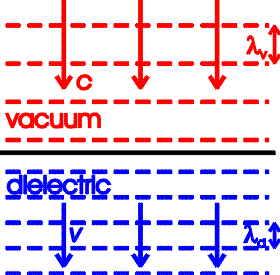
Light in a dielectric medium
When light enters a dielectric medium (e.g. plastic or glass) the electric fields are affected by the dielectric material, which reduces the speed of light in the medium. No energy is lost in this process, and when the light leaves the medium it immediately speeds back up to its original speed c in the vacuum.
The index of refraction n specifies the amount of slowing:

The index of refraction is always greater than unity; nothing moves faster than the speed c of light in vacuum.
This is illustrated in the figure on the right: the wave
fronts are shown by dashed lines.
 When light enters a dielectric as
shown, the speed of the signal slows down while the frequency stays the same. This is
analogous to automobile traffic entering a slow stretch of road. In that instance, the
number of cars passing any given point per second is the same everwhere, which corresponds
to the frequency being the same. But the spacing between the cars is reduced, which
corresponds to the wavelength of light
ld
in the dielectric being smaller than the wavelength
lv in the vacuum.
When light enters a dielectric as
shown, the speed of the signal slows down while the frequency stays the same. This is
analogous to automobile traffic entering a slow stretch of road. In that instance, the
number of cars passing any given point per second is the same everwhere, which corresponds
to the frequency being the same. But the spacing between the cars is reduced, which
corresponds to the wavelength of light
ld
in the dielectric being smaller than the wavelength
lv in the vacuum.
